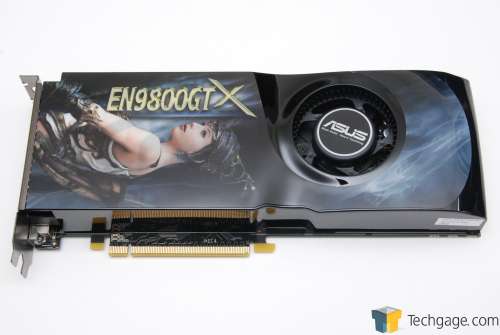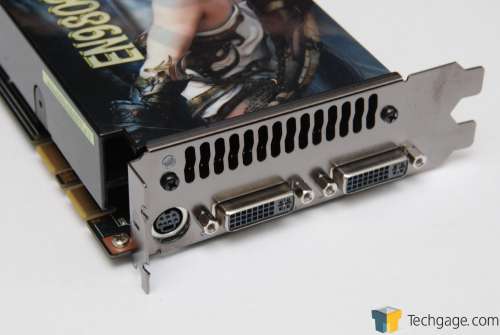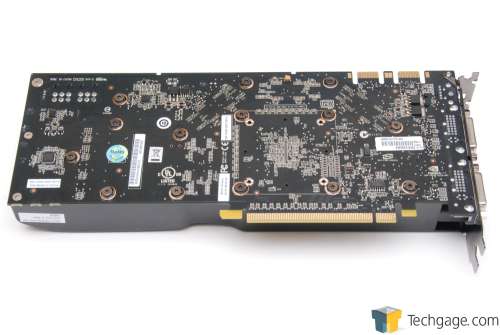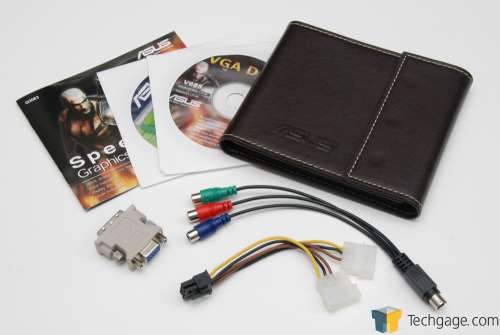- Qualcomm Launches Snapdragon 4 Gen 2 Mobile Platform
- AMD Launches Ryzen PRO 7000 Series Mobile & Desktop Platform
- Intel Launches Sleek Single-Slot Arc Pro A60 Workstation Graphics Card
- NVIDIA Announces Latest Ada Lovelace Additions: GeForce RTX 4060 Ti & RTX 4060
- Maxon Redshift With AMD Radeon GPU Rendering Support Now Available
ASUS EN9800GTX 512MB
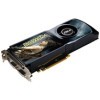
It’s not too often that the fastest single-GPU available is also affordable, but the 9800 GTX is just that. At just over $300, it delivers incredible performance at all resolutions and also turns out to be amazingly overclockable. It’s just too bad that the 8800 GTS 512 is not much slower…
Page 1 – Introduction, Look at the EN9800GTX 512MB
When thinking about NVIDIA’s usage of the term “GTX”, what’s the first thing that comes to mind? For me, I think of “Good To The Xtreme”. Granted, I threw in a second T in there, but that’s not what’s important. GTTX doesn’t quite have the same ring to it. But it stands true… GTX is a moniker that to me, represents incredible performance… performance that’s the top of its class.
We saw that first with the 7800 GTX and then with the 8800 GTX. The 8800 GTX is particularly a perfect example of that fact. Despite the fact that it was first released in late 2006, it remained the biggest performer all the way until this past December, where it was succeeded in performance by the 8800 GTS 512. There was of course the 8800 Ultra, but that was a quick release with a simple speed bump, whereas the GTS 512 had substantial upgrades that made a real difference.
But it stands to reason, for a single GPU to hold the top spot for an entire year… is impressive. So with that, welcome to the 9800 GTX, a card that makes a mockery the GTX moniker.
Blunt? Perhaps. Truth? Most definitely. It might sound like I don’t like the 9800 GTX, but that’s far from the truth. I just don’t feel it deserves to wear the GTX name, in any shape or form. In reality, this is a 9800 GTS, as it’s clearly a successor to the 8800 GTS 512.
At the root, the 9800 GTX is indeed an 8800 GTS 512 card, only with higher clocks. In fact, as we found out in our recent review of the ASUS EN8800GTS 512, the 9800 GTX doesn’t even stand a chance where a small overclock is involved. Even though the ASUS 8800 GTS 512 card was equipped with a modest overclock, it beat the 9800 GTX in almost every test.
Should a next-gen graphics card be trumped so easily be a last-gen card? I don’t think so.
Closer Look
Contrary to how that introduction sounded, the 9800 GTX is an incredible graphics card, and one that should be considered for a new build or as an upgrade. I mentioned in the introduction that when the 8800 GTX was first released, it was the top of its class for quite a while. What I didn’t mention was that when that card was first released, it cost near $600. The 9800 GTX, on the other hand, can be had for $330. What a difference a year and a half can make.
The fact of the matter is, NVIDIA is kicking some serious ass right now. Their lineup fills every market segment, and regardless of what you are looking for, NVIDIA has it. Take a look at the recent 9600 GT for example. That card is impressive, and with a modest overclock, it can match the performance of a slightly more expensive 8800 GT, making it a great purchase decision for most anyone.
Or how about the ability to go Quad-GPU with the help of two 9800 GX2s? It doesn’t matter what your budget is, or what you are going for. Both AMD or NVIDIA have what you need. Lately, however, NVIDIA is pushing out the faster performing parts, making their cards a more realistic choice, unless revamped pricing skews things.
|
Model
|
Core MHz
|
Shader MHz
|
Mem MHz
|
Memory
|
Memory Bus
|
Stream Proc.
|
| 8600 GT |
540
|
1190
|
700
|
256MB
|
128-bit
|
32
|
| 8600 GTS |
675
|
1475
|
1000
|
256MB
|
128-bit
|
32
|
| 8800 GS |
550
|
1375
|
800
|
384MB
|
192-bit
|
96
|
| 9600 GT |
650
|
1625
|
900
|
512MB
|
256-bit
|
64
|
| 8800 GT |
600
|
1500
|
900
|
512MB
|
256-bit
|
112
|
| 8800 GTS 320/640 |
500
|
1200
|
800
|
320/640MB
|
320-bit
|
96
|
| 8800 GTS 512 |
650
|
1625
|
970
|
512MB
|
256-bit
|
128
|
| 9800 GTX |
675
|
1688
|
1100
|
512MB
|
256-bit
|
128
|
| 8800 GTX |
575
|
1350
|
900
|
768MB
|
384-bit
|
128
|
| 8800 Ultra |
612
|
1500
|
1080
|
768MB
|
384-bit
|
128
|
If I sounded disinterested in this card in the intro, I think this specs table could explain why. Yes, the 9800 GTX is indeed faster than the 8800 GTS 512, but it’s far from being “next-gen” material. The Core Clock has been bumped up 25MHz, the Shader Clock is up 63MHz, while the Memory Clock has been pushed to a very healthy 1100MHz. That extra boost in memory should make up for any lack of overall memory density, if there is such a thing with today’s games.
With their EN9800GTX, ASUS chose to stick to the reference cooler, but not before adorning the face of the card with a mythical beauty. After all, she’s what makes the card run faster. Right?
The cooler itself runs itself to the very end of the card, with air holes at the end to allow cool air to come in, which the leaf-blower fan then picks up to push out through the back. You might also notice the two PCI-E power connectors. Allow me to rant again.
The 9800 GTX is, in essence, a higher-clocked 8800 GTS 512, as I’ve established about fifteen times so far. What’s the reason for dual PCI-E connectors, then? While this doesn’t make much sense to me, it will allow for better and more stable overclocking, although I’m still not going to assume that the card wouldn’t have worked fine with a single power cable.
If SLI is in the cards (no pun), then you have two choices. Either pick up a beefier PSU, or try your luck with using Molex-to-PCI-E power converters, which your cards would include. As long as you have a sufficient PSU, there should be no issue in doing things this way.
The reference 9800 GTX cooler is identical at the back to the previous 8800 GTX cooler, which makes sense as it’s practical. There is an opening large enough to allow an ample amount of warm air to escape throughout the back. Also here is a TV-Out port and dual DVI ports.
For those pondering a purchase of an after-market cooler, here is a shot of the back that should help. The layout is similar, but not identical, to the 8800 GTX layout, so 8800 GTX after-market coolers will not likely fit. So if you are to purchase a cooler, make sure that the manufacturer explicitly states support for the 9800 GTX.
The ASUS bundle with this card isn’t terribly impressive, but sometimes, it doesn’t need to be. Included is a Molex-to-PCI-E converter, TV-Out cable, driver and manual CDs and also a nice leather-like CD holder.
I admit… I would have liked to see a game bundled here, but most often, those are given to post-launch cards, or TOP cards, to help sweeten the deal. Even an HDMI adapter would have been nice, though, as even the lowly EN9600GT included one.
On the next page, we will take a look at our current testing methodology, which we recommend you take a look at if you have not already. Our methodologies tend to be far different than most sites. On page 3, we will jump straight into our test results.
Support our efforts! With ad revenue at an all-time low for written websites, we're relying more than ever on reader support to help us continue putting so much effort into this type of content. You can support us by becoming a Patron, or by using our Amazon shopping affiliate links listed through our articles. Thanks for your support!




